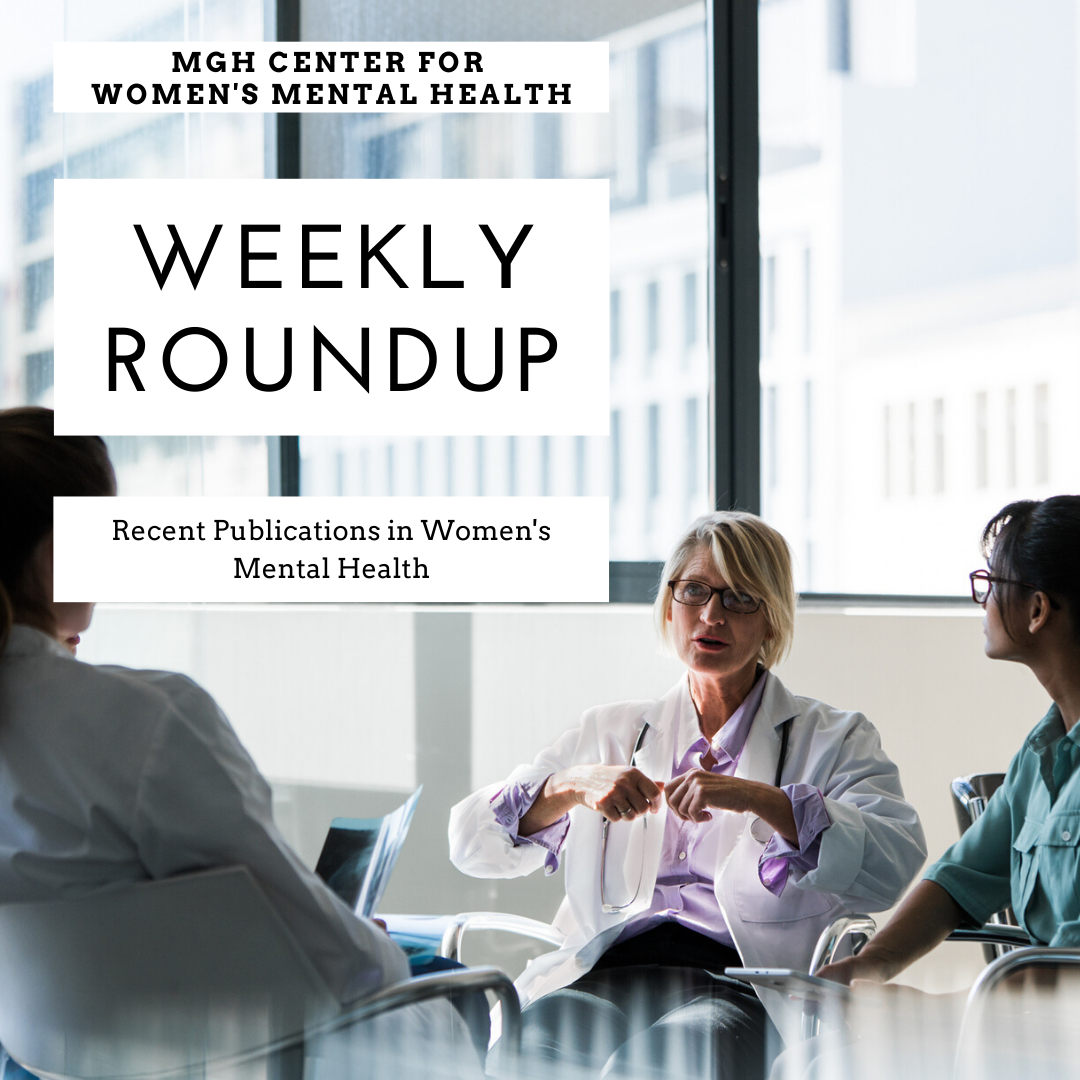
Every week we review the most recent publications in women’s mental health, covering topics related to premenstrual symptoms, perinatal mood and anxiety disorders, use of medications in pregnant and breastfeeding women, perinatal substance use, and menopausal mental health.
For more detailed descriptions of many of these topics, you can sign up to receive our weekly CWMH NEWSLETTER which comes out every Thursday.
And don’t forget to visit ESSENTIAL READS – a curated selection of up-to-date and clinically relevant articles in women’s mental health.
Ruta Nonacs, MD PhD
PMS AND PMDD |
| No articles this week |
INFERTILITY AND MENTAL HEALTH |
| No articles this week |
PSYCHIATRIC ILLNESS DURING PREGNANCY |
| Mental health of pregnant and postpartum women during the third wave of the COVID-19 pandemic: a European cross-sectional study.
Tauqeer F, Ceulemans M, Gerbier E, Passier A, Oliver A, Foulon V, Panchaud A, Lupattelli A, Nordeng H. BMJ Open. 2023 Jan 11;13(1):e063391. The prevalence of major depressive symptoms (EDS ?13) was 16.1% in the pregnancy group and 17.0% in the postpartum . Moderate to severe generalized anxiety symptoms (GAD ?10) were found among 17.3% of the pregnant and 17.7% of the postpartum women. Risk factors associated with poor mental health included having a pre-existing mental illness, a chronic somatic illness, having had COVID-19 or its symptoms, smoking, unplanned pregnancy and country of residence. |
| Perinatal Mood and Anxiety Disorders: biomarker discovery using plasma proteomics.
Accortt E, Mirocha J, Zhang D, Kilpatrick SJ, Libermann T, Karumanchi SA. Am J Obstet Gynecol. 2023 Jan 14:S0002-9378(23)00016-9. From a panel of 53 significant PMAD-associated proteins a unique 20 protein signature differentiated PMAD cases from controls on principal component analysis (P<0.05). These proteins included molecules such as NCAM1, NRCAM, NTRK3 that converge around neuronal signaling pathways regulating axonal guidance, astrocyte differentiation and maintenance of GABAergic neurons. |
| Evaluating the Effectiveness of the Supportive Parenting App on Parental Outcomes: Randomized Controlled Trial.
Shorey S, Law E; Thilagamangai; Mathews J, Lim SH, Shi L, Chua JS, Du R, Chan YH, Tan TC, Chee C, Chong YS. J Med Internet Res. 2023 Jan 16;25:e41859. Parents in the intervention group generally fared better, especially regarding perceived social support. However, the lack of statistical significance in most outcomes showed the limited effectiveness of the parenting intervention, which may be because of the COVID-19 pandemic. |
| Risk Factors Associated With Peripartum Suicide Attempts in Japan.
Akaishi T, Tarasawa K, Fushimi K, Hamada H, Saito M, Kobayashi N, Kikuchi S, Tomita H, Ishii T, Fujimori K, Yaegashi N. JAMA Netw Open. 2023 Jan 3;6(1):e2250661. Risk factors associated with prepartum suicide attempts included younger age (adjusted odds ratio [aOR], 0.99; 95% CI, 0.98-1.00) and histories of personality disorder (aOR, 10.81; 95% CI, 5.70-20.49), depression (aOR, 3.97; 95% CI, 2.35-6.70), schizophrenia (aOR, 2.89; 95% CI, 1.52-5.50), and adjustment disorder (aOR, 2.66; 95% CI, 1.07-6.58). Risk factors associated with postpartum suicide attempts included younger age (aOR, 0.96; 95% CI, 0.93-1.00), heavy tobacco use (aOR, 23.09; 95% CI, 5.46-97.62), and histories of alcohol use disorder (aOR, 163.54; 95% CI, 28.30-944.95), personality disorder (aOR, 10.28; 95% CI, 3.29-32.10), anxiety disorders (aOR, 8.13; 95% CI, 2.88-22.98), depression (aOR, 7.27; 95% CI, 2.95-17.91), schizophrenia (aOR, 5.77; 95% CI, 2.17-15.38), bipolar disorder (aOR, 3.98; 95% CI, 1.36-11.67), and insomnia (aOR, 3.17; 95% CI, 1.30-7.78). |
| Brain development after intrauterine exposure to lithium: a magnetic resonance imaging study in school-age children.
Poels EMP, Kamperman AM, Bijma HH, Honig A, van Kamp IL, Kushner SA, Hoogendijk WJG, Bergink V, White T. Bipolar Disord. 2023 Jan 12. In this primary analysis of 30 children with and 33 without intrauterine exposure to lithium, researchers found no statistically significant associations between intrauterine exposure to lithium and structural brain measures. There was a non-significant trend towards reduced subcortical gray matter volume. |
POSTPARTUM PSYCHIATRIC ILLNESS |
| Twin pregnancy and severe maternal mental illness: a Canadian population-based cohort study.
Lapinsky SC, Ray JG, Brown HK, Murphy KE, Kaster TS, Vigod SN. Arch Womens Ment Health. 2023 Jan 11. In the first 365 days postpartum, severe mental illness occurred at rates of 10.5 and 8.7 per 1000 person-years in twin and singleton mothers, respectively, corresponding to a hazard ratio (HR) of 1.21 (95% CI 1.07-1.47). From 366 days onward, the corresponding figures were 5.9 and 6.1 per 1000 person-years (HR 0.96, 95% CI 0.89-1.04). Wells MB, Jeon L. J Affect Disord. 2023 Jan 11:S0165-0327(22)01524-5. Fathers’ depression symptoms and coparenting quality can be bi-directionally related in the association with father-infant bonding. Early detection and preventive treatments for paternal depression symptoms and coparenting are warranted. |
| The effect of counseling with stress management approach on postpartum anxiety and distress and breastfeeding self-efficacy during COVID-19 pandemic: a ramdomized controlled trial.
Shamsdanesh S, Nourizadeh R, Hakimi S, Ranjbar F, Mehrabi E. BMC Pregnancy Childbirth. 2023 Jan 13;23(1):26. Stress management counseling can improve postpartum anxiety and distress and breastfeeding self-efficacy and increase breastfeeding. |
| Postpartum Psychosis or Something Else?
Madora MJ, Knopf HS, Prakash M, Kim J, Medavaram MR, Vaughn RL. Prim Care Companion CNS Disord. 2023 Jan 5;25(1):22nr03269. case vignette and review of the relevant literature to highlight the broad differential diagnosis of postpartum psychosis with atypical features. |
| Postpartum Psychosis.
Friedman SH, Reed E, Ross NE. Curr Psychiatry Rep. 2023 Jan 13:1-8. doi: 10.1007/s11920-022-01406-4. REVIEW. |
| Endorsement of a single-item measure of sleep disturbance during pregnancy and risk for postpartum depression: a retrospective cohort study.
Felder JN, Roubinov D, Zhang L, Gray M, Beck A. Arch Womens Ment Health. 2023 Jan 12. Prenatal sleep disturbance was associated with higher odds of postpartum depressive symptoms (aORs 1.9, 95% CI 1.2-3.1 for first trimester; 3.7, 95% CI 1.5-11.5 for second trimester; 3.4, 95% CI 1.9-6.8 for third trimester). Fatigue and appetite disturbance in the first and third trimesters were associated with higher odds of postpartum depressive symptoms. |
MEDICATIONS AND BREASTFEEDING |
| No articles this week |
PERINATAL SUBSTANCE USE |
| No articles this week |
MATERNAL MENTAL HEALTH AND CHILD OUTCOMES |
| No articles this week |
MENOPAUSE AND MENTAL HEALTH |
| No articles this week |
OTHER TOPICS IN WOMEN’S MENTAL HEALTH |
| No articles this week |



Leave A Comment